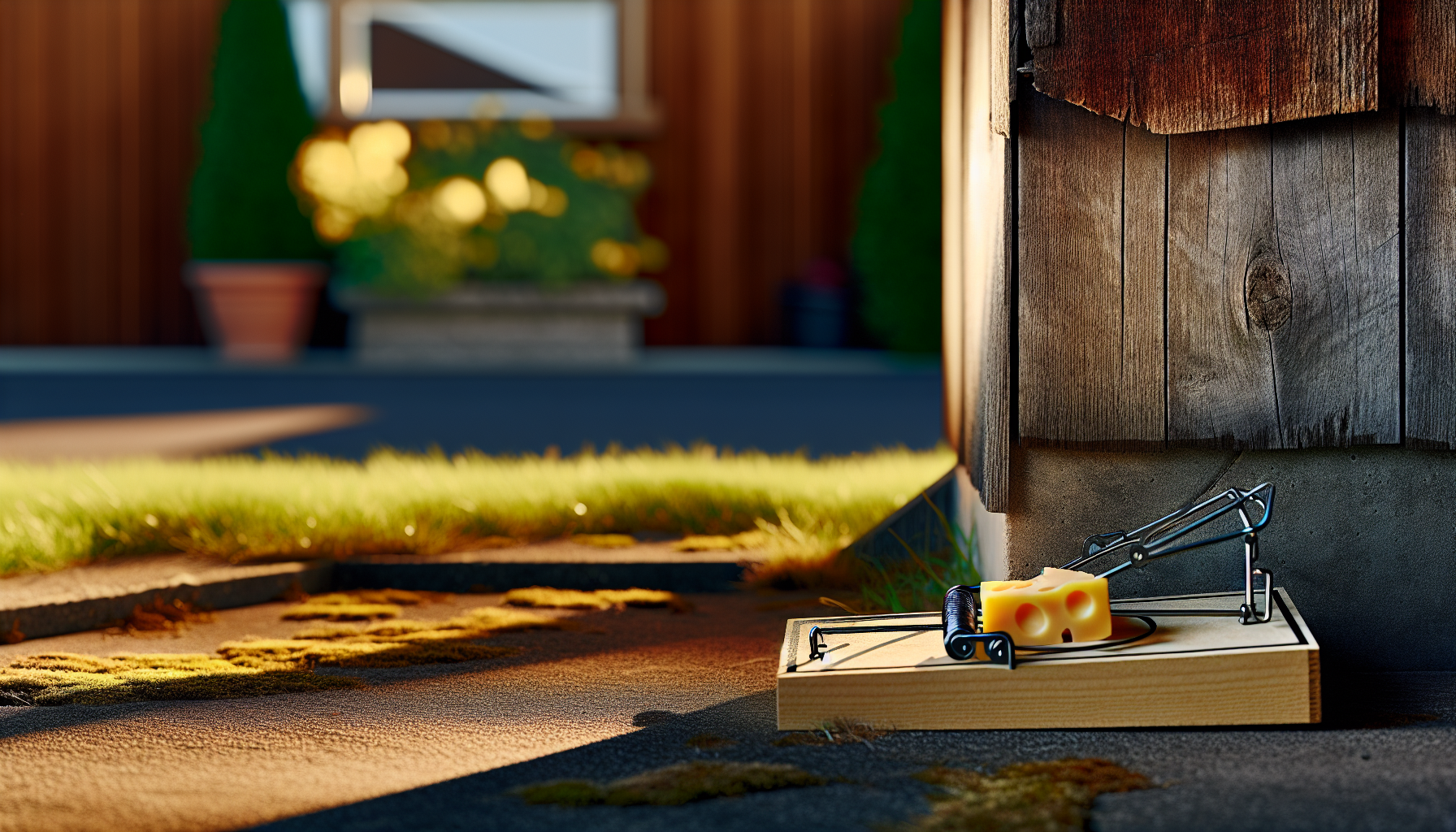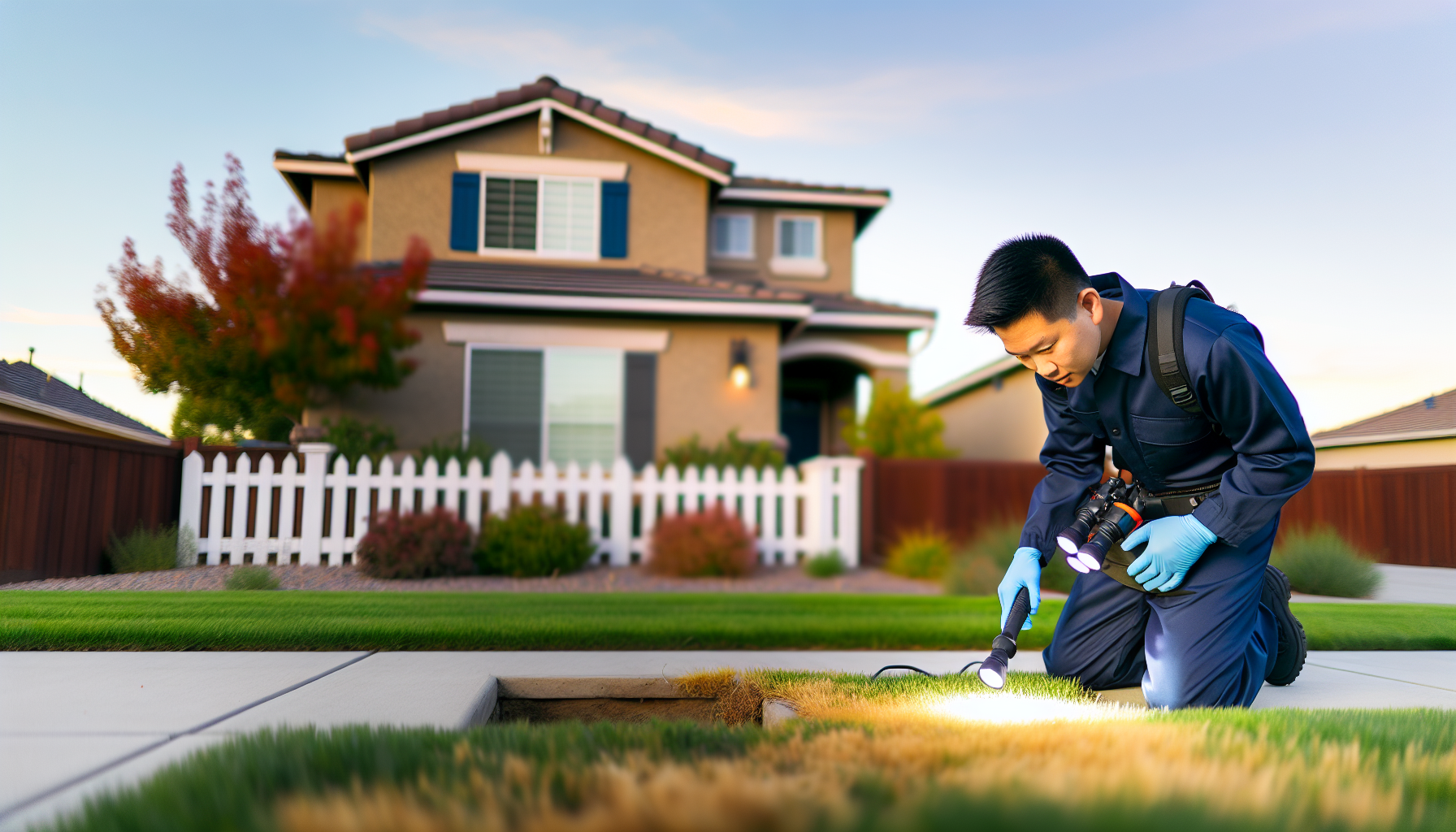Effective Rat Removal: Top Strategies for a Rodent-Free Home
Facing unwelcome rats? Effective rat removal starts here. Learn how to swiftly identify and eliminate rats with our straightforward, expert-backed strategies. No fluff—just the essential steps you need to reclaim a rodent-free home, outlined in the following article.
Key Takeaways
- Signs of a rat infestation include live or dead rats, droppings, noises, pet behavior changes, and musky odors; identifying the type of rat can help apply proper control measures.
- Effective rat control strategies encompass full exclusion techniques, sanitation best practices, and carefully placed traps to capture or kill rats.
- Professional pest control services are beneficial for severe infestations, offering expert inspection, customized control strategies, preventative solutions, and follow-up services to ensure a rat-free home.
Identifying Rat Presence: Key Indicators

Identifying a rat infestation can be challenging as rats are nocturnal creatures that prefer to stay hidden. However, you can be on the lookout for certain key indicators. Here are some signs of a rat infestation:
- Spotting a live or dead rat
- Finding rat droppings
- Noticing gnaw marks on furniture or walls
- Hearing scratching or scurrying noises in the walls or ceiling
- Discovering nests or burrows
- Detecting a strong, musky odor
Even a solitary sighting of a roof rat can suggest a larger problem as rats, including common rats like roof rats and Norway rats, are adept at hiding in secluded spots such as wall voids, attics, and crawl spaces.
Your pets are often the first to notice a rat problem. They may exhibit unusual behavior such as barking, clawing at walls or floors, or fixating on a particular area. These signs could indicate an awareness of rat presence. In addition to this, certain auditory cues can also signal rat infestation. Sounds such as scratching or scurrying noises coming from within walls are common indicators of rat activity.
There is a variety of rat species that may invade your home including roof rats, Norway rats, and black rats among others. Identifying the type of rat can aid in implementing effective control measures. The upcoming sections will guide you on how to confirm a rat presence in your home and promptly address the problem.
Sightings of Live or Dead Rats
Spotting a rat, whether dead or alive, unmistakably signals a rat infestation. Rats are typically seen in low-traffic areas such as:
- the attic
- the basement
- the back of a closet
- an undisturbed corner of a garage
Locating these spots is the first step towards implementing effective rat removal strategies.
The presence of a deceased rodent within your residence, especially during daylight hours, indicates a sizable infestation. Distinguishing between rats and mice is also crucial for effective rodent control. Rats are larger in size, have longer and thicker tails, and heavier bodies compared to mice. Proper bait selection and strategic trap placement in areas of rat activity are key to success.
Unusual Pet Behavior
Often, pets are the first to signal to homeowners the presence of rats. Dogs may display behaviors such as barking, digging, or sitting and staring at areas where they detect rats. On the other hand, cats may exhibit their hunting instincts, especially when rats are in motion.
Although cats are natural predators, they may not be as proficient in deterring larger rodents like rats. Therefore, while pet behavior can be an early warning sign, rat control requires a more comprehensive approach.
Sounds from the Walls
Your quiet house during the day may fill with eerie noises come nightfall. If you are hearing scratching, rustling, or scurrying noises from within your walls, it could be an indication of rat activity.
These sounds are particularly noticeable during the quiet nighttime hours, aligning with rats’ peak activity. The composition and construction of the walls can influence the amplification of these sounds, making them noticeable to the human ear.
Essential Steps in Rat Control

Now that you’ve identified the presence of rats in your home, the next step is to implement rat control strategies. This includes full exclusion, sanitation best practices, and effective trapping techniques.
Full exclusion entails:
- A detailed home inspection to find the source of the infestation
- Pinpointing entry points like broken drains, garage door cracks, vent holes, and foundation gaps
- Sealing these entry points to control rat infestation.
Sanitation measures, on the other hand, aim to eliminate access to food, water sources, and harborage areas where rats can nest. Trapping is recommended for eliminating rats indoors due to its non-toxic nature and the ability to verify effectiveness through captured rats. The upcoming sections will delve into each of these rat control strategies in more detail.
Full Exclusion Tactics
Initiating full exclusion starts with a detailed home inspection to pinpoint active rat entry points. Some signs to look for include:
- Grease marks
- Runways
- Urine stains
- A close examination of areas under and around windows, doors, and foundations
These inspections can reveal openings larger than ¼ inch or small holes as tiny as a dime that could potentially serve as entry points for rats.
Sealing these entry points is essential to prevent rat intrusion. Any gap, crack or space that is ¼ inch or larger should be sealed. For effective sealing, materials such as:
- hardware cloth
- wire screen
- lightweight sheet metal
- steel wool
- waterproof seals
are suggested.
Sanitation Best Practices
High standards of sanitation are indispensable to rat control. It involves eliminating the fundamental requirements of rats including food, water, and shelter. For instance, food waste, meat scraps, and other organic matter should be disposed of properly by sealing trash cans with lids, maintaining cleanliness both inside and outside the container, and disposing of trash regularly.
Maintaining cleanliness in your house helps minimize the appearance of rats by eliminating their access to food sources and reducing their shelter options. Natural repellents like proper disposal of food scraps and garbage can also be effective in keeping rats away.
Effective Trapping Techniques
Setting traps is a practical and non-toxic approach to controlling rodents. Traps such as glue traps, snap traps, bait stations, and rat traps are popular options for home use. Using rat bait in combination with these traps can increase their effectiveness.
Setting up these traps requires strategic placement in areas with visible rodent activity. For snap traps, it’s recommended to position the traps perpendicular to the wall with the trigger end near the wall. Solid baits like peanut butter or nesting materials like cotton or dental floss can be used for effective baiting.
Removing Attractants: Minimize Rodent Appeal

Beyond exclusion and sanitation, it’s equally important to get rid of rats by eliminating potential rat attractants in your home. This includes securing your garbage, managing pet food, and protecting your garden.
Securing your garbage can involves ensuring that the lid is tightly closed, using heavy-duty trash bags, and maintaining cleanliness both inside and outside the container.
When it comes to pet food, it is advisable to keep it in secure containers and avoid leaving it in bedrooms or on terraces as these areas can attract rats and serve as a food source for them.
The subsequent sections will provide a more in-depth exploration of these strategies designed to minimize rodent appeal.
Secure Your Garbage
Rats are scavengers and are highly attracted to garbage. A crucial deterrent is to ensure your garbage cans are properly secured. Here are some steps you can take:
- Ensure that the lid of the garbage can is tightly closed.
- Use heavy-duty trash bags to prevent rats from tearing through them.
- Maintain cleanliness both inside and outside the container to minimize odors that attract rats.
- Dispose of trash regularly to prevent it from accumulating and attracting rats.
By following these steps, you can help prevent rats from being attracted to your garbage cans.
Avoid leaving food scraps or open trash cans that can attract rodents. Regular disposal of garbage and storing it in a trash can equipped with a secure-fitting lid diminishes the opportunity for rats to access the waste.
Indoor Pet Food Strategies
Rats are also significantly attracted to pet food. Therefore, it’s important to store pet food properly to prevent rodents from accessing it. Storing pet food in secure containers such as the IRIS Airtight Pet Food Storage Container & Scoop Combo and the Gamma2 Vittles Vault Dog Food Storage Container can effectively keep rodents at bay.
In addition, it is recommended to avoid keeping food in bedrooms or on terraces, as these areas can attract rats and serve as a food source for them. By managing pet food effectively, you can significantly reduce the likelihood of a rat infestation.
Garden Protection Tips
Preventing rats from invading your garden can pose a significant challenge. Cultivating rat-repellent plants such as:
- mint
- basil
- echinacea
- chrysanthemums
- rosemary
- sage
- lavender
- marigolds
can naturally discourage rats from inhabiting your garden.
To protect your vegetable garden, strategies such as:
- using rat zappers or traps
- planting deterrents like mint
- sprinkling cayenne pepper around
- using ultrasonic devices such as the RATSAK® REPEL™ ULTRASONIC RODENT REPELLER PRO
can be effective in deterring rats and mice from gardens.
The Role of Professional Pest Control in Rat Removal

Despite the effectiveness of DIY pest control methods, situations may arise when professional pest control services become indispensable. Pest control experts have the knowledge and skills to identify rat entry points and find nesting and food storage areas. They can remove rats from your home without causing further damage..
Professional pest control services also offer preventive solutions and follow-up services to ensure long-term rat control success. It is recommended to seek the assistance of a professional exterminator if you have rats in your walls, are dealing with a significant rat infestation, or if your attempts at do-it-yourself rat removal prove unsuccessful.
Subsequent sections will expand on the crucial role of professional pest control in rat removal and managing the rat population.
Expert Inspection and Assessment
Professional rat inspection encompasses:
- A thorough visual assessment that uncovers potential entry points
- Monitoring rodent activity
- Evaluating the surrounding environment
- Scrutinizing high-risk areas within the property.
This expert evaluation can:
- Identify vulnerabilities and points of entry
- Enable professionals to proactively take measures to deter rats
- Provide customized pest control solutions
- Aid in detecting potential infestations before they escalate into serious issues.
Customized Rat Control Services
Customized rat control service offers a specialized pest control solution, tailored to meet the unique needs of your home. This may include the use of tailored pest control methods and products to efficiently eradicate rats from your premises.
Customized rat control services take into account the type of rats present and implement personalized prevention and removal strategies that are most effective for your specific situation. These services are specifically crafted to address the unique rat control requirements of your property.
Preventive Solutions and Follow-Up
Implementing preventive solutions and follow-up services is key to ensuring the long-term success of rat control. These services include:
- Sealing off any remaining entry points
- Studying rodent behavior and habits to enhance future infestation prevention
- Strengthening and confirming the efficacy of preventive measures
Regular monitoring is essential as it facilitates early identification of new rat infestations, enabling prompt intervention to mitigate property damage and health hazards, thus ensuring a rat-free environment.
Decontamination and Repair Post-Rat Removal

Following rat removal, the subsequent step involves decontamination and repair. This involves rat fumigation, cleaning up droppings and nesting materials, and performing necessary repairs such as replacing insulation and fixing damaged wood or wires.
Rat droppings and nesting materials can harbor dangerous bacteria and pathogens such as Hantavirus. To safeguard oneself, it is advisable to utilize heavy-duty gloves, an N95 or HEPA mask, and disposable coveralls when dealing with rat clean-up.
The forthcoming sections will guide you through the process of decontamination and repair after rat removal.
Rat Fumigation Essentials
Rat fumigation constitutes an important phase of the decontamination process. It involves the application of aerosol chemicals in:
- walls
- rooms
- attics
- crawl spaces
to target various nesting locations.
The chemicals typically used in rat fumigation include:
- Rodenticides
- Baits with attractive substances
- Strychnine
- Zinc phosphide
- Bromethalin
- Cholecalciferol
- Sulfur dioxide
- Carbon monoxide
- Hydrogen cyanide
- Methyl bromide
Cleanup of Droppings and Nesting Materials
The decontamination process significantly involves cleaning up rat droppings and nesting materials, as well as taking measures to kill rats. This involves:
- wearing gloves
- spraying the area with a disinfectant or a mixture of bleach and water
- allowing the solution to soak for at least 5 minutes to achieve desired results
This step ensures that the solution has enough time to penetrate and effectively work on the surface.
Once soaked, the droppings and nesting material should be wiped up using paper towels or rags, then sealed in a plastic bag before being disposed of in a covered trash container. It’s important to remember that handling rat droppings and nesting materials can pose health hazards and appropriate precautions should be taken.
Home Repairs and Restoration
After rat removal, essential home repairs may entail addressing damage to elements like drywall, electrical lines, HVAC, and insulation. Reinforcing vents with copper wire or stainless steel mesh can also prevent future infestations.
Replacing insulation damaged by rats can be done using foams that are sprayed or injected. If the damage is confined to a small area, only the damaged areas can be removed and replaced.
Repairing wood damaged by rats involves:
- Sealing off entry points with steel wool or caulk
- Plugging holes in exterior walls
- Repairing gnawed wooden fixtures
- Sealing visible holes or gaps with sturdy materials like copper mesh.
Summary
In conclusion, rat control is not a one-time process but a comprehensive strategy that involves identifying the presence of rats, implementing effective rat control measures, removing attractants, and restoring your home post-rat removal. It’s essential to stay vigilant, as it’s much easier to prevent a rat infestation than it is to remove one. The strategies outlined in this guide will provide a good starting point in maintaining a rat-free home.
Frequently Asked Questions
What is the fastest way to get rid of rats?
The fastest way to get rid of rats is through pest control, but using mouse traps, snap traps, chemical baits, and live traps are also effective methods to eliminate them quickly and effectively.
What keeps rats away permanently?
You can keep rats away permanently by using natural rodent repellents like peppermint oil, chili powder, citronella, and eucalyptus, or chemical smells like ammonia, bleach, and mothballs. Using these methods will help ensure a long-term solution to keeping rats away.
What is the best method for rat control?
The best method for rat control is trapping and placing rodent baits. This method effectively eliminates rats from your property.
How hard are rats to get rid of?
Rats are intelligent and adaptable creatures, making it difficult to get rid of them once they infest a home due to their capabilities and behavior. It may take longer to eliminate a severe infestation, and ongoing treatment might be needed to keep them away.
What are the key indicators of rat presence in my home?
The key indicators of rat presence in your home include sightings of live or dead rats, unusual pet behavior, and sounds coming from the walls. Keep an eye out for these signs to address the issue promptly.
